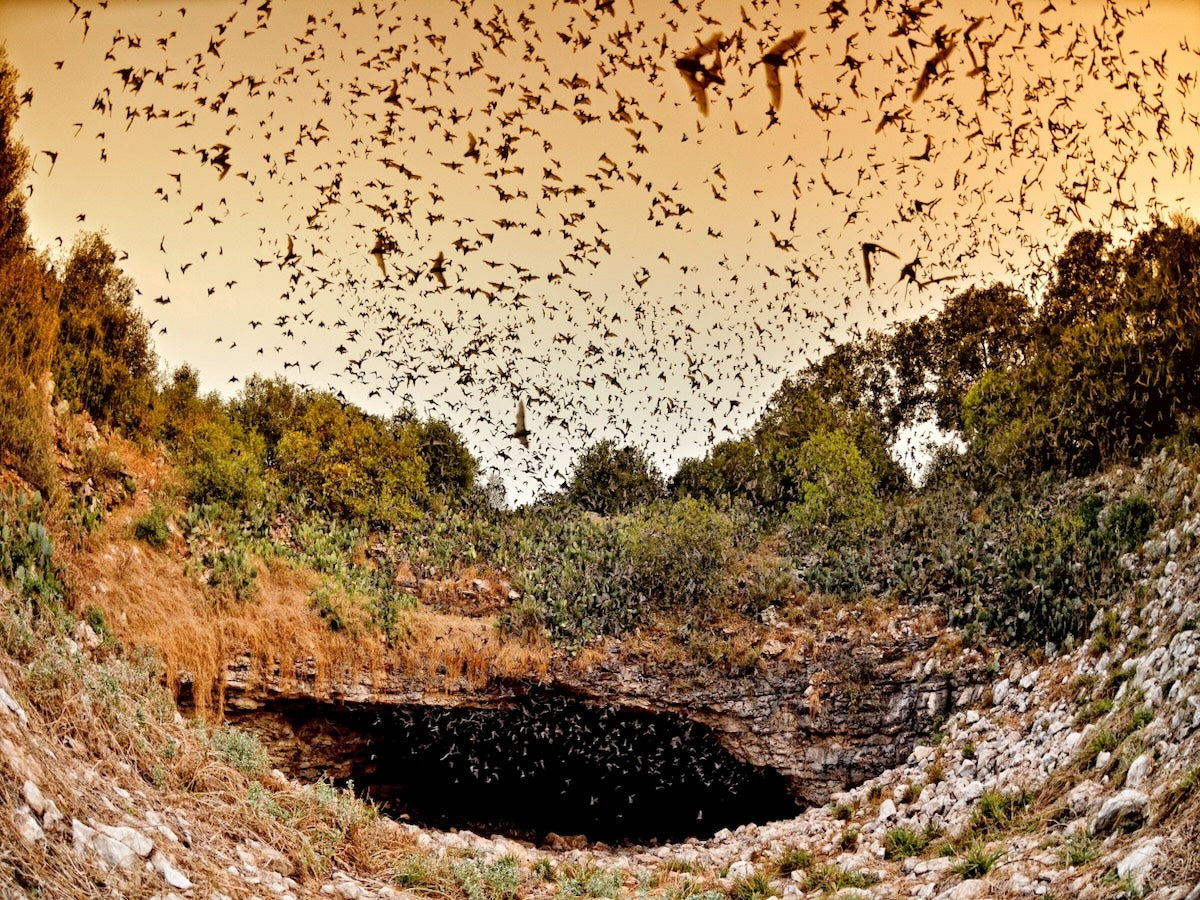Bracken Cave Bat Preserve, Photo by Jonathan Alonzo, Courtesy of Bat Conservation International
Bats are incredibly valuable to our ecosystem, but often, they're misrepresented, and their existence can feel like a mystery.
Curiosity got the best of us this time, so we set out to discover more about their world, guided by the expertise of Erin Cord, a wildlife biologist who works at Bat Conservation International.
In our interview with Erin, she shed light on the environmental significance of bats, their struggles, and how we can help them thrive. So, let's swoop on in and learn more about bats, shall we?
Leaf Shave: What's White-nose Syndrome?
Bat Conservation International: White-nose Syndrome is a disease in hibernating bats caused by the fungus Pseudogymnoascus destructans (Pd for short). The fungus was first detected in the United States in 2006, and since then, it has continued to spread west across the country. The disease is deadly to many hibernating bats, causing them to starve to death during winter months. Since 2006, millions of bats have been killed, and scientists have been working hard to try to stop this deadly disease. To learn the latest about White-nose Syndrome and how you can help visit whitenosesyndrome.org.
LS: How did bats evolve? Are they related to birds or rodents?
BCI: Based on the current fossil record, we think bats evolved from tree-dwelling placenta-having mammals. This evolution happened a long time ago, as the earliest recognizable bats have been observed in fossils from around 50 million years ago. The bat fossil record still has some big gaps and paleontologists are trying to figure out how the tree-dwelling placental mammal became the flying mammals we know today.
Bats are mammals (in the taxonomic Class Mammalia), and birds are in a different taxonomic class, called Aves. Although superficially bats resemble rodents, research has determined that they are more closely related to horses! Bats live much longer than other mammals that are similar in size—the longest-living bat we know of so far was 41 years old—and they reproduce very slowly, giving birth to just one pup per year.

Greater Bulldog Bat (Noctilio leporinus) uses its feet to collect insects fluttering on lake surface, Barro Colorado Island, Panama. Photo by Christian Ziegler/Minden Pictures, Bat Conservation International
LS: Are bats considered sacred or spiritual?
BCI: Yes! Bats are revered or considered sacred in many cultures. In India, for example, bats are worshipped in many temples where people believe they bring prosperity and wealth. In Chinese culture, bats are regarded as lucky animals, and the word bat sounds like the word blessing! These are just a few examples, but culturally, bats don’t always carry the negative connotations associated with American and European views.
LS: How many insects do bats eat daily?
BCI: It depends on the species, but in general (for insectivorous bats) the answer is A LOT! Estimates range from 2,000 insects per night. Female bats that are pregnant eat even more, consuming their body weight in insects every single night. Can you imagine eating your body weight in food in one night? Yikes! Bats eat a wide range of insects, but many of their favorites to munch are species we consider pests.
LS: Are there any places that do not have bats?
BCI: Bats are found on every single continent except Antarctica! There are over 1,400 species of bats in the world adapted to all different climates and habitats.
LS: Why do bats sleep upside-down?
BCI: Sleeping upside down offers some serious advantages for bats. Bats generally can’t run to take off from the ground to fly, so if they’re hanging upside down, all they need to do is drop and go. Also, bat feet have a special adaptation where their tendons lock in place when they hang, so they don’t exert any extra energy to hold on to the surface. It’s also a space saver — you can pack a lot of bats into a space when you’re hanging upside down!
LS: How “blind” are bats, and where did the phrase “blind as a bat” come from?
BCI: This phrase came from the mistaken assumption that since bats use echolocation (sound) to get around at night, their eyesight isn’t very good. Bats generally see about as well as we do, and in some species (like Fruit Bats), they have eyesight that is even better than our own in low light conditions.
LS: What kinds of plants attract bats? Do they pollinate them?
BCI: Bats pollinate over 500 different species of ecologically and economically important plants. In the United States, most of our bats eat insects, but we do have some pollinating species in the Desert Southwest. Those bats pollinate agave plants as well as some species of cacti. If you’re lucky enough to live where there are pollinating bats, they will also visit your hummingbird feeder at night!

Uroderma bilobatum roosting under large leaf. Barro Colorado Island, Panama. Photo by Christian Ziegler/Minden Pictures, Bat Conservation International
LS: Where are the best places to see bats?
BCI: Lucky for us bats are everywhere in the United States! During summer months you can often spot them at dusk flying around hunting for food. A good trick is to hang out by a lake or pond at sunset. One of the first things bats do when they wake up is go get a drink, so you can often see them visiting water. You can also visit a larger bat colony to see an emergence. BCI has a great interactive map of spots all over the world! Or, tune into our live cam at Bracken Cave in San Antonio.
LS: How far from your house should you place a bat house?
BCI: You can put a bat house directly on your house — actually we recommend it! Bat houses are the most successful when they are put up on buildings. Just make sure you put it somewhere you don’t mind guano accumulating.
LS: What should I do if I find a bat in my house?
BCI: The first thing to do is stay calm! Know that the bat doesn’t want to be there and means you no harm. One of the best things to do is to open the windows and turn out the lights. Sometimes the bat will find their own way out of your house. If you need to remove the bat yourself, always wear heavy gloves and long sleeves. DO NOT touch the bat directly. We have some step-by-step instructions on our website here. If you aren’t sure what to do, you can contact a local bat rehabilitator and they will help!
“In clear-cut areas of rainforest, fruit bats are responsible for 95% of new plant growth.”
LS: How does plastic pollution affect bat colonies?
BCI: I think we’re still trying to understand this, but unsurprisingly, studies indicate that microplastics can negatively impact bat health. It has been shown that bats often ingest microplastics through flying insects, and these contaminants can accumulate over their lifetime. This can cause issues in the bat’s digestive tract and certain organs, possibly making them more susceptible to disease.
LS: In what ways are bats beneficial to the environment?
BCI: Bats are incredibly important to the environment in a variety of ways. Insect-eating bats perform pest control services free of charge all around the world! One study estimated that bats save the United States agricultural industry billions of dollars every year by eating insects that are considered crop pests. As I mentioned above, bats pollinate over 500 different species of plants. This includes wild agaves, which is what gives us tequila. So next time you have a margarita, make sure you raise your glass to the bats!

Photo by Nils Bouillard on Unsplash
LS: What can our customers do locally to support their bat population?
BCI: There are lots of great ways to support your local bats. Get to know the species in your area and be a bat advocate! People still have a lot of misconceptions about bats, and you can make a big difference by debunking those myths and talking about why bats are great. You can also support your local bat rehabilitators. Since bats require specialized care, many bat rehabilitators work solo. They often support their work out of pocket and always welcome donations and sometimes volunteers.
______
Bats are vital contributors to ecological balance, serving as key agents in pollination, pest control, and seed dispersal, thus playing an indispensable role in sustaining our planet's health. Through fostering awareness and backing organizations such as Bat Conservation International (BCI), we can actively contribute to the preservation of bat populations for future generations.
We are delighted that Erin Cord and Bat Conservation International took the time to discuss various aspects of bat ecology and conservation efforts. We encourage everyone to explore BCI's website for more resources, upcoming events, and avenues to support their invaluable research initiatives. Additionally, as part of our commitment to environmental stewardship, a portion of proceeds from Fig razor sales will be donated to BCI throughout Earth Month.
More about Erin Cord:
Erin is the Community Partnerships Manager at Bat Conservation International (BCI) and proudly works with communities in ways that benefit both bats and people. She is a wildlife biologist by trade but pivoted to more of an engagement/education role after graduate school. Erin adores all things bats and has worked at BCI since 2019. Erin's most memorable bat experience (so far) was her first visit to Bracken Cave in San Antonio, TX. As she witnessed the emergence of 20 million Mexican free-tailed bats, she remembers tearing up and getting goosebumps.

Erin Cord with her son at Bracken Cave
More on bats:
Bat Conservation International






